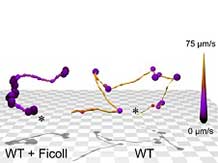Bacteria and complex fluids
The ability to track swimming bacteria in a fluid gives the opportunity to probe their internal state very accurately, and how this state is coupled to their environment. For example, bacteria can sense external gradients of nutrients and toxins, and modulate their swimming behaviour in order to avoid these. We are interested in how this behaviour is achieved, on a large scale and in complex environments like visco-elastic (sticky/squidgy) fluids and structured media. Our imaging technique readily allows us to image thousands of micrometre-scale swimming cells in a millimetre-scale volume, giving excellent statistics and high throughput. The image accompanying this text comes from the paper by Kühn et al. (see below) in which we collaborated with Kai Thormann’s group in Giessen and Bruno Eckhardt’s group in Marburg.
Key Publications
M.J. Kühn, F.K. Schmidt, N.E. Farthing, F.M. Rossmann, B. Helm, L.G. Wilson, B. Eckhardt & K.M. Thormann. Nat. Commun. 9 5369 (2018).
M. Morse, R. Colin, L.G. Wilson & J.X. Tang. Biophys. J. 110(9) 2076–2084 (2016).
V.A. Martinez, J. Schwarz-Linek, M. Reufer, L.G. Wilson, A.N. Morozov & W.C.K. Poon. Proc. Natl. Acad. Sci. USA 111(50) 17771 (2014).
R. Colin, R. Zhang & L.G. Wilson. J. R. Soc. Interface 11 20140486 (2014).
L.G. Wilson, V.A. Martinez, J. Schwarz-Linek, J. Tailleur, G. Bryant, P. N. Pusey & W. C. K. Poon. Phys. Rev. Lett. 106 018101 (2011).

